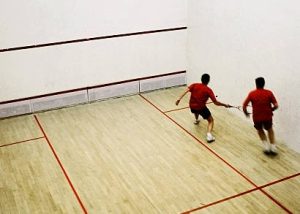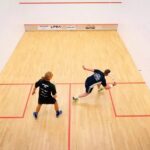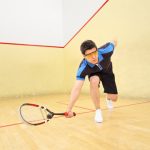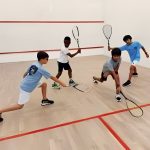To excel on the squash court, players must continuously work on their skills and techniques, one crucial aspect of squash training is ball feeding, particularly in the front corners. Proper ball-feeding drills can significantly enhance a player’s ability to retrieve and control shots from these challenging areas, ultimately improving overall performance on the court.

Squash Front Corners Ball Feeding is a specific training technique used in squash to improve a player’s ability to handle shots that land in the front corners of the court. In squash, the front corners refer to the areas near the sidewalls and close to the short line on either side of the court.
During Front Corners Ball Feeding drills, a coach or training partner feeds the ball to the player in a controlled and deliberate manner, directing shots to the front corners. The player then practices retrieving and returning these shots from challenging positions. The primary objectives of this training are to enhance footwork, accuracy, control, retrieval skills, reaction time, and decision-making in the front corners.
This training method is essential because the front corners in squash are notoriously difficult to access and control. Shots that land in these areas often force players into awkward positions, making it challenging to execute accurate returns. By repeatedly practising front corners ball feeding, players develop the necessary skills and muscle memory to effectively handle shots from these tight angles and improve their overall performance on the squash court.
The Significance of Front Corners Ball Feeding
Front corners in squash are notorious for being the most difficult areas to access and control. Shots that land close to the sidewalls and near the short line often force players into awkward positions, making it challenging to execute accurate returns. By incorporating specific ball feeding exercises into your training routine, you can develop the necessary skills to handle these tricky situations effectively.
Footwork and Movement: Footwork is the foundation of any successful squash player, and mastering it is essential for handling shots in the front corners. Ball feeding drills focusing on this area will help you improve your movement to reach the ball quickly and efficiently. Practice lateral movements, split-steps, and lunges to ensure you’re always in the best position to respond to front corner shots.
Accuracy and Control: Consistency and precision are critical elements of squash, so when practising front corners ball feeding, concentrate on delivering accurate shots to simulate real-game scenarios. Vary the speed and angles of your feeds to challenge yourself and improve your ability to control the ball upon retrieval. Remember, the more accurately you feed the ball, the more opportunities you’ll have to refine your technique.
Retrieval Skills: Front corners ball feeding drills are excellent for honing your retrieval skills. Work on anticipating shots and positioning yourself optimally to handle the ball effectively. By practising retrieving shots from tight angles, you’ll develop the muscle memory required to perform at your best during competitive play.
Reaction Time: Squash is a fast-paced game that demands quick reactions. Front corners ball feeding drills help sharpen your reflexes and responsiveness. As you become more adept at reacting swiftly to challenging shots, you’ll gain a competitive edge, leaving your opponents struggling to keep up.
Decision Making: In front corners, you may have several options to return the ball, each with its benefits and risks. Ball feeding drills can help you simulate different scenarios, allowing you to make quick, smart decisions under pressure.
This ability to read the game and choose the best shots will give you a significant advantage over your opponents.
Coaching juniors on Front Corners Ball Feeding
For junior squash players, mastering front corners ball feeding drills can significantly enhance their game and overall performance on the court. These drills are essential for developing footwork, accuracy, control, and decision-making skills. Here are some tips to help junior players excel in front corners ball feeding training:
Start with Basic Footwork: Before diving into complex ball feeding drills, focus on mastering the fundamental footwork techniques. Emphasize lateral movements, quick changes of direction, and proper split steps to ensure junior players are always balanced and ready to react to shots in the front corners.
Gradually Increase Difficulty: Introduce ball feeding drills with slow and straightforward shots initially. As the juniors become more comfortable, gradually increase the difficulty by incorporating faster and more challenging angles. This approach will help them build confidence and competence over time.
Practice Consistency: Consistency is key in squash. Encourage junior players to focus on delivering accurate and repeatable shots during ball feeding. Consistent feeds will allow them to develop muscle memory and improve their ability to control the ball in the front corners.
Vary Feed Angles and Heights: To simulate real-game scenarios, vary the angles and heights of ball feeds. This practice will prepare juniors to handle shots that come in at different angles, allowing them to adapt and respond effectively during matches.
Incorporate Random Feeds: While practising front corners ball feeding, introduce random feeds to challenge juniors’ reaction time and decision-making skills. Random feeds force them to think quickly and choose the appropriate shot to return, enhancing their game intelligence.
Focus on Retrieval Skills: Front corners ball feeding drills are an excellent opportunity for junior players to work on their retrieval skills. Encourage them to move swiftly, anticipate shots, and position themselves optimally to retrieve the ball effectively.
Use Targets for Accuracy: Set up targets on the front corners of the court to improve accuracy. Encourage juniors to aim for these targets during ball feeding drills, aiming to hit the ball consistently into the designated areas.
Emphasize Proper Technique: During training, place emphasis on using the proper squash technique, even during ball feeding exercises. Correct grip, body positioning, and swing mechanics are crucial for executing shots accurately and efficiently.
Mix in Competitive Drills: Introduce friendly competitions among junior players during ball feeding drills. For example, see who can hit the most targets or successfully return the most challenging shots. This approach adds an element of fun and motivation to their training.
Following the end of training, consider an end with game-like situations that will allow the juniors to practice various front corners ball feeding drills. Doing so will allow the juniors to retrieve shots from the front corners and transition into offensive play. This final step bridges the gap between drills and real-game situations.
Final Thoughts
Incorporating front corners ball feeding into your squash training regimen is an invaluable step toward becoming a formidable player on the court. Developing footwork, accuracy, retrieval skills, reaction time, and decision-making through these drills will not only improve your performance in the front corners but also enhance your overall squash game.
For juniors front corners ball feeding drills are a valuable tool to help them develop their skills and become well-rounded athletes on the court; encourage consistent practice, provide constructive feedback, and instil a love for the sport to inspire them to continue improving their game. With dedication and perseverance, young players can take their squash skills to new heights and enjoy the sport to its fullest.
By dedicating time and effort to front corners ball feeding drills, you’ll build the confidence and skills needed to excel in challenging situations during competitive matches.
Remember to practice regularly and push yourself beyond your comfort zone to maximize the benefits of these training exercises.





